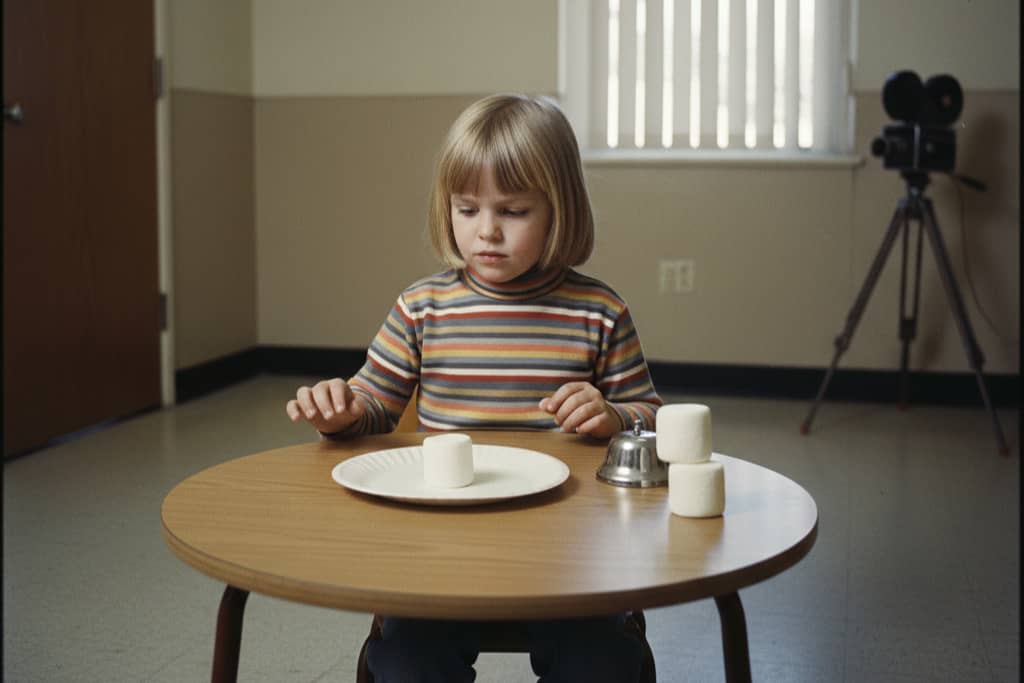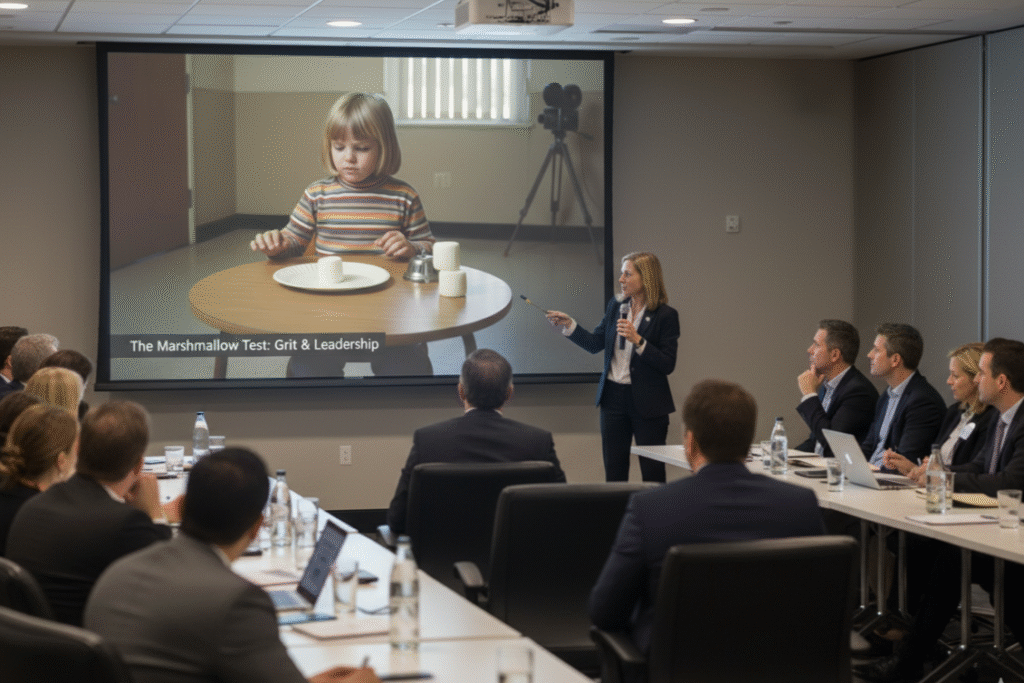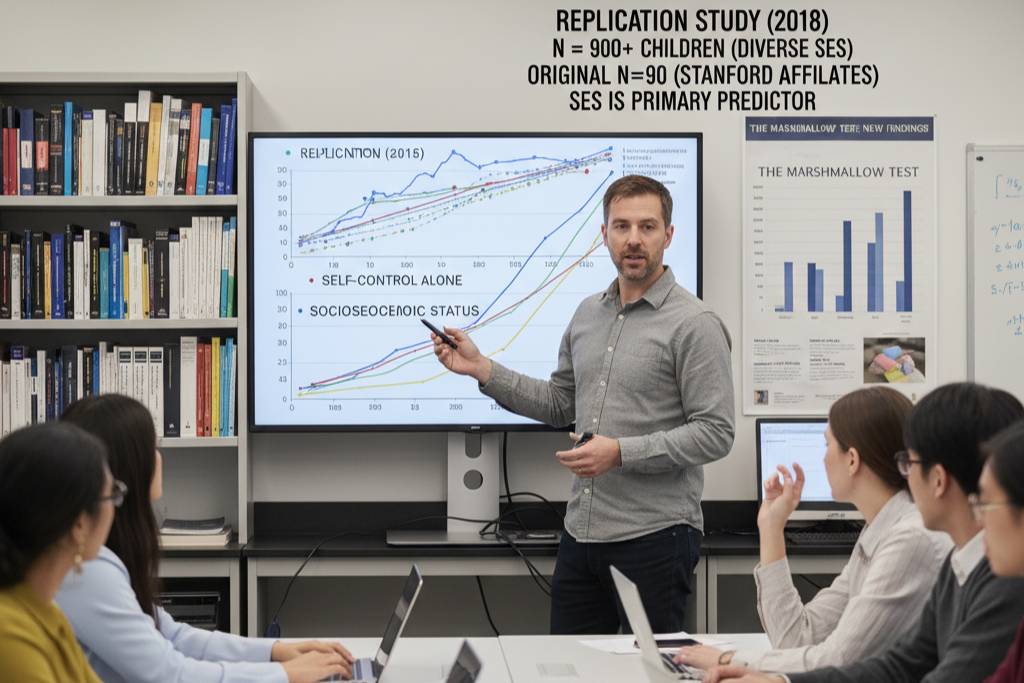1. A Sweet Dilemma

In the late 1960s and early 1970s, Stanford psychologist Walter Mischel and his team ran the original experiments, often with four-year-olds from the Stanford University campus’ Bing Nursery School. The setup was famously simple: a child was placed alone in a room with one marshmallow (or another treat), and an experimenter gave them a choice. They could ring a bell and eat the treat immediately, or they could wait until the experimenter returned in about 15 minutes, at which point they would receive a second marshmallow. The core dilemma wasn’t just about candy; it was a simple, measurable way to observe a child’s ability to delay gratification, a psychological concept that had, until then, been difficult to study in a laboratory setting.
2. The Promise of Self-Control

The central hypothesis driving Mischel’s research was the idea that an early ability to resist temptation was a foundational skill, an indicator of what psychologists termed “executive functions.” These cognitive skills, which include planning, flexible thinking, and self-control, were believed to be crucial for navigating complex social and academic challenges. Researchers saw the waiting child as possessing superior self-regulation, suggesting this single trait could reliably predict a host of positive life outcomes. The marshmallow, therefore, became an early, tangible symbol of the willpower thought to be essential for achieving long-term goals like earning better grades, maintaining healthier weight, and establishing stable relationships.
3. The Famous Follow-Ups

Beginning in the late 1980s, Mischel’s research team conducted longitudinal follow-up studies, tracking the children as they grew into adolescents and young adults. The initial, highly publicized findings seemed to confirm the hypothesis: the children who had successfully waited for the second marshmallow scored, on average, 210 points higher on the SAT than those who had given in to temptation quickly. This correlation suggested that the simple act of delaying gratification at age four was a powerful, independent predictor of academic aptitude and greater life success. These early results catapulted the test into psychological stardom, seemingly providing definitive proof that discipline in childhood shaped destiny in adulthood.
4. The Cultural Impact

The Marshmallow Test quickly escaped the confines of academia and became a cultural phenomenon, referenced everywhere from television shows to corporate leadership training seminars. It was embraced by the public as a straightforward, easily digestible narrative about success: if you want a better life, you must sacrifice now for a bigger reward later. This framing resonated with popular concepts of “grit” and “willpower,” making the study a cornerstone of many parenting guides and self-help books. The simple image of a child resisting a fluffy treat became a powerful, almost mythological pop culture shorthand for the triumph of discipline over instant gratification.
5. The Challenge to the Results

In the 2010s, new researchers, notably psychologist Tyler Watts, re-examined the original findings using a larger and more diverse group of over 900 children, compared to the original, smaller cohort which was primarily composed of children of Stanford faculty and students. This replication study, published in 2018, found that while there was still a link between waiting time and later success, the correlation was significantly weaker than initially reported, especially when considering a child’s background. Crucially, Watts’ study found that a child’s socioeconomic status (SES), a measure of family income and parental education, accounted for most of the predictive power, not just self-control alone.
6. Poverty and Patience

The replication studies highlighted a critical factor: a child’s environment fundamentally changes the rationality of their choice. For children growing up in unstable, low-income environments, promises from adults, whether of a second marshmallow or of future financial stability, are often unreliable. In this context, eating the single marshmallow immediately is not a failure of willpower, but a rational survival strategy. It guarantees a known reward, whereas waiting for an uncertain future reward that might never materialize is a risky choice. This reframing demonstrated that a child’s decision was heavily influenced by their learned belief in the reliability of their world.
7. What It Really Proved

The modern consensus is that the Marshmallow Test measures much more than just a child’s intrinsic self-control. It primarily reveals a child’s learned trust in the stability of their environment and the credibility of the adult making the promise. Children from privileged backgrounds are more likely to have a history of adults following through on promises, making the choice to wait a safe bet. The experiment, therefore, became a complex diagnostic tool, showing how early life circumstances, like consistent caregiving and economic stability, profoundly shape a child’s ability and willingness to believe in delayed rewards.
8. Lessons for Parenting Today

For modern parents, the revised understanding of the Marshmallow Test offers a more nuanced approach than simply enforcing rules. The key takeaway is that discipline works best when paired with security. Instead of solely focusing on teaching a child to wait, parents are encouraged to build a predictable, reliable home environment where promises are consistently kept. A child who feels safe, supported, and confident that their needs will be met is naturally more likely to internalize the value of delayed gratification because they trust that the larger, promised reward will actually appear.
9. Lessons for Education

The Marshmallow Test’s flaws offer educators a crucial insight: apparent impulsivity in the classroom is not always a character flaw. A student who struggles with patience or focus may be reflecting the underlying uncertainty of their home life, where consistency is rare. Educational strategies, therefore, should move beyond simply rewarding “grit” and focus on creating stable, predictable classroom environments where every student feels safe and understood. This perspective suggests that addressing basic needs and building trusting relationships can be a prerequisite for developing self-regulation skills.
10. The Business World Connection

The concept of delayed gratification is a cornerstone of business success, often applied to concepts like long-term investment, building a brand slowly, or prioritizing research and development over quick profits. The modern twist on the Marshmallow Test, however, serves as a warning to corporate culture. While individual discipline is valued, it only flourishes in a stable system. An employee is only willing to sacrifice personal time or short-term rewards if they trust that the company (the “adult” in the room) will follow through on its long-term promises of career advancement, fair compensation, and job security.
11. The Smartphone Twist

Today, the marshmallow has been digitized and multiplied, manifesting as endless notifications, social media feeds, and instant entertainment on our smartphones. The core psychological dilemma remains: do you choose the instant, easy pleasure of checking your phone now, or do you stay focused on a cognitively demanding task for a bigger, but delayed, payoff like completing a report or finishing a chapter? In this sense, the Marshmallow Test is more relevant than ever, offering a powerful metaphor for the constant mental tug-of-war between productivity and digital distraction in the 21st century.
12. Mental Health Takeaway

The test’s evolution has reshaped how mental health professionals view impulsivity. Previously, a lack of self-control might have been solely diagnosed as a deficit in willpower or a symptom of a disorder. Now, therapists are trained to look at a patient’s background, trauma, and systemic instability. For a person who has experienced significant trauma or lived in an unpredictable environment, acting impulsively (grabbing the marshmallow) can be a deeply ingrained, rational coping mechanism for survival, not simply a sign of psychological weakness.
13. A Symbol of Inequality

As the test’s results were scrutinized, it became a powerful, albeit unintended, symbol of socioeconomic inequality. It illustrated how economic privilege could manifest as an apparent moral virtue (patience), while economic disadvantage could be mislabeled as a moral failure (impulsivity). In effect, children from more stable, affluent homes could afford to wait because their world was reliable, whereas children from struggling homes were making a necessary calculation based on scarcity and uncertainty. The marshmallow became less a measure of a child’s character and more a mirror reflecting society’s systemic divides.
14. Why It Still Matters

Despite the significant challenges to its original interpretation, the Marshmallow Test endures because it speaks to a universal human condition: the conflict between our present self and our future self. Whether the goal is dieting, saving for retirement, quitting a bad habit, or studying for an exam, we are constantly faced with a choice between an immediate, small comfort and a later, greater reward. The test provides a simple, compelling framework for understanding this fundamental struggle, which is why it continues to be taught, debated, and referenced across disciplines.
15. The Final Bite

The Marshmallow Test did not provide a magic formula for predicting success, nor did it isolate willpower as the singular ingredient for a good life. Its true legacy is its evolution: it taught the world that self-control is not a fixed, innate trait that exists in a vacuum. Instead, it showed that a child’s decision, to wait or not to wait, is a complex product of their own cognitive development, their trust in the adults around them, and the reliable or unpredictable nature of the world they inhabit. The marshmallow’s lesson is ultimately one of context: opportunity and trust matter as much as discipline.
This revised understanding of the Marshmallow Test offers a rich perspective on patience, parenting, and privilege. What surprised you the most about the updated research?
This story The Marshmallow Test: 15 Lessons From the Experiment That Tried to Predict Success was first published on Daily FETCH


